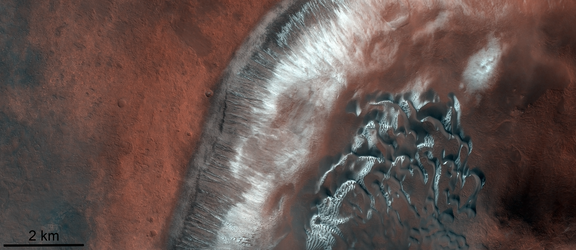

Science & Exploration
Argyre impact basin after spring equinox
This image of the Argyre impact basin in the southern highlands of Mars was taken on 28 April 2020 just as Mars had passed its southern hemisphere spring equinox. The seasonal ice in the 800km-long impact basin is receding while the ridge on the right side of the image is still covered with frost. The image is centred at 57.5°S, 310.2°E. The frost-covered ridge is facing the pole, therefore receiving less solar radiation than the neighbouring equator-facing slope. On Mars, incoming solar radiation transforms the ice into water vapour directly without melting it first into water in a process called sublimation. Since the north-facing slope (on the left) has had a longer exposure to solar radiation, its ice has sublimated more quickly.





